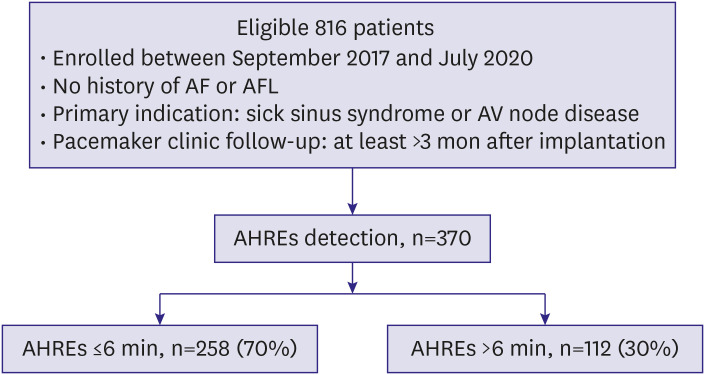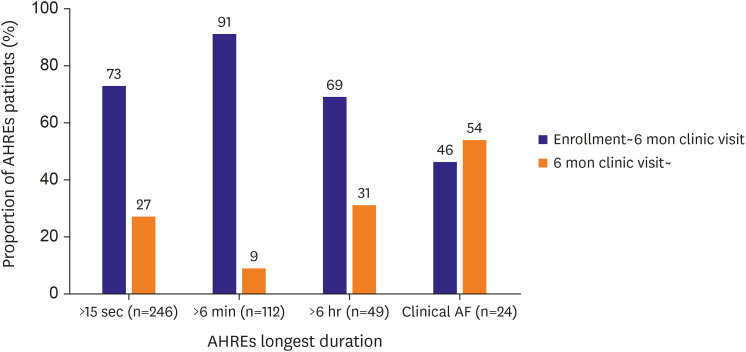Korean Circ J.
2021 Mar;51(3):235-247. 10.4070/kcj.2020.0393.
Prevalence and Predictors of Clinically Relevant Atrial High-Rate Episodes in Patients with Cardiac Implantable Electronic Devices
- Affiliations
-
- 1Division of Cardiology, Yonsei University Health System, Seoul, Korea
- 2Department of Cardiology, Seoul National University Bundang Hospital, Seongnam, Korea
- 3Department of Cardiology, Seoul National University Hospital, Seoul, Korea
- 4Division of Cardiology, Keimyung University Hospital, Daegu, Korea
- 5Department of Cardiology, Ewha Womans University Hospital, Seoul, Korea
- 6Division of Cardiology, Daegu Catholic University Hospital, Daegu, Korea
- 7Division of Cardiology, Eulji University Hospital, Daejeon, Korea
- 8Department of Cardiology, Korea University Hospital, Seoul, Korea
- 9Department of Cardiology, CHA Bundang University Hospital, Seongnam, Korea
- KMID: 2513521
- DOI: http://doi.org/10.4070/kcj.2020.0393
Abstract
- Background and Objectives
Atrial high-rate episodes (AHREs) can be continuously detected by cardiovascular implantable electronic devices (CIEDs); however, the predictors of clinically relevant AHREs are unclear.
Methods
This prospective multicenter study monitored 816 patients (median age 73 years, 40.4% male) without atrial fibrillation (AF) from September 2017 to July 2020. AHREs was defined as a programmed atrial detection rate >220 beats/min. The reference values of 6 minutes and 6 hours were set to analyze clinical implication of AHREs based on previously published data that the 6 minutes excluded most episodes of oversensing.
Results
During a median follow-up of 18 months (interquartile interval 9–26 months), AHREs with the longest durations of >15 seconds, >6 minutes, and >6 hours and clinically documented AF by electrocardiography were noted in 246 (30.1%), 112 (13.7%), 49 (6.0%), and 24 (2.9%) patients, respectively. Among patients developing AHREs >6 minutes, 102 (91.1%) of 112 patients were identified at the 6-month visit. Patients with AHREs >6 minutes had higher proportions of sick sinus syndrome, subjects with atrial premature beat >1% on Holter monitoring, and larger left atrium (LA) size than patients with AHREs ≤6 minutes. Multivariable logistic regression analysis showed that LA diameter >41 mm (odds ratio [OR], 2.08; 95% confidence interval [95% CI], 1.25–3.45), and sick sinus syndrome (OR, 3.22; 95% CI, 1.91–5.43) were associated with AHREs >6 minutes.
Conclusions
In patients with LA diameter >41 mm, and sick sinus syndrome before CIEDs implantation is associated with risk of developing AHREs >6 minutes.
Keyword
Figure
Cited by 2 articles
-
Can Current Subclinical Atrial Fibrillation Be Verified by P Wave of 12-Lead ECG at Present? The Answer Already Exists in the Atrial Substrate
Seung Yong Shin
Korean Circ J. 2023;53(9):632-634. doi: 10.4070/kcj.2023.0188.Device-Detected Subclinical Atrial Fibrillation as Fire Under the Ashes
Seung-Jung Park
Korean Circ J. 2023;53(7):497-498. doi: 10.4070/kcj.2023.0136.
Reference
-
1. Healey JS, Connolly SJ, Gold MR, et al. Subclinical atrial fibrillation and the risk of stroke. N Engl J Med. 2012; 366:120–129. PMID: 22236222.
Article2. Brambatti M, Connolly SJ, Gold MR, et al. Temporal relationship between subclinical atrial fibrillation and embolic events. Circulation. 2014; 129:2094–2099. PMID: 24633881.
Article3. Glotzer TV, Hellkamp AS, Zimmerman J, et al. Atrial high rate episodes detected by pacemaker diagnostics predict death and stroke: report of the Atrial Diagnostics Ancillary Study of the MOde Selection Trial (MOST). Circulation. 2003; 107:1614–1619. PMID: 12668495.4. Glotzer TV, Daoud EG, Wyse DG, et al. The relationship between daily atrial tachyarrhythmia burden from implantable device diagnostics and stroke risk: the TRENDS study. Circ Arrhythm Electrophysiol. 2009; 2:474–480. PMID: 19843914.5. Kim D, Yang PS, Jang E, et al. 10-year nationwide trends of the incidence, prevalence, and adverse outcomes of non-valvular atrial fibrillation nationwide health insurance data covering the entire Korean population. Am Heart J. 2018; 202:20–26. PMID: 29802976.
Article6. Tse HF, Lau CP. Prevalence and clinical implications of atrial fibrillation episodes detected by pacemaker in patients with sick sinus syndrome. Heart. 2005; 91:362–364. PMID: 15710720.
Article7. Capucci A, Santini M, Padeletti L, et al. Monitored atrial fibrillation duration predicts arterial embolic events in patients suffering from bradycardia and atrial fibrillation implanted with antitachycardia pacemakers. J Am Coll Cardiol. 2005; 46:1913–1920. PMID: 16286180.
Article8. Mittal S, Stein K, Gilliam FR 3rd, Kraus SM, Meyer TE, Christman SA. Frequency, duration, and predictors of newly-diagnosed atrial fibrillation following dual-chamber pacemaker implantation in patients without a previous history of atrial fibrillation. Am J Cardiol. 2008; 102:450–453. PMID: 18678304.9. Gonzalez M, Keating RJ, Markowitz SM, et al. Newly detected atrial high rate episodes predict long-term mortality outcomes in patients with permanent pacemakers. Heart Rhythm. 2014; 11:2214–2221. PMID: 25131667.
Article10. Ziegler PD, Glotzer TV, Daoud EG, et al. Detection of previously undiagnosed atrial fibrillation in patients with stroke risk factors and usefulness of continuous monitoring in primary stroke prevention. Am J Cardiol. 2012; 110:1309–1314. PMID: 22819433.
Article11. Kaufman ES, Israel CW, Nair GM, et al. Positive predictive value of device-detected atrial high-rate episodes at different rates and durations: an analysis from ASSERT. Heart Rhythm. 2012; 9:1241–1246. PMID: 22440154.
Article12. Kirchhof P, Benussi S, Kotecha D, et al. 2016 ESC Guidelines for the management of atrial fibrillation developed in collaboration with EACTS. Eur Heart J. 2016; 37:2893–2962. PMID: 27567408.13. January CT, Wann LS, Alpert JS, et al. 2014 AHA/ACC/HRS guideline for the management of patients with atrial fibrillation: executive summary: a report of the American College of Cardiology/American Heart Association Task Force on practice guidelines and the Heart Rhythm Society. Circulation. 2014; 130:2071–2104. PMID: 24682348.14. Gorenek B. Device-detected subclinical atrial tachyarrhythmias: definition, implications and management-an European Heart Rhythm Association (EHRA) consensus document, endorsed by Heart Rhythm Society (HRS), Asia Pacific Heart Rhythm Society (APHRS) and Sociedad Latinoamericana de Estimulacion Cardiaca y Electrofisiologia (SOLEACE) (vol 19, pg 1556, 2017). Europace. 2018; 20:658. PMID: 29059282.15. Pedersen KB, Madsen C, Sandgaard NC, Diederichsen AC, Bak S, Brandes A. Subclinical atrial fibrillation in patients with recent transient ischemic attack. J Cardiovasc Electrophysiol. 2018; 29:707–714. PMID: 29478291.
Article16. Lopes RD, Alings M, Connolly SJ, et al. Rationale and design of the apixaban for the reduction of thrombo-embolism in patients with device-detected sub-clinical atrial fibrillation (ARTESiA) trial. Am Heart J. 2017; 189:137–145. PMID: 28625370.
Article17. Belkin MN, Soria CE, Waldo AL, et al. Incidence and clinical significance of new-onset device-detected atrial tachyarrhythmia: a meta-analysis. Circ Arrhythm Electrophysiol. 2018; 11:e005393. PMID: 29540371.
Article18. Gillis AM, Morck M. Atrial fibrillation after DDDR pacemaker implantation. J Cardiovasc Electrophysiol. 2002; 13:542–547. PMID: 12108493.
Article19. Healey JS, Martin JL, Duncan A, et al. Pacemaker-detected atrial fibrillation in patients with pacemakers: prevalence, predictors, and current use of oral anticoagulation. Can J Cardiol. 2013; 29:224–228. PMID: 23142343.20. Healey JS, Alings M, Ha A, et al. Subclinical atrial fibrillation in older patients. Circulation. 2017; 136:1276–1283. PMID: 28778946.
Article21. Wong JA, Conen D, Van Gelder IC, et al. Progression of device-detected subclinical atrial fibrillation and the risk of heart failure. J Am Coll Cardiol. 2018; 71:2603–2611. PMID: 29880119.
Article22. Mahajan R, Perera T, Elliott AD, et al. Subclinical device-detected atrial fibrillation and stroke risk: a systematic review and meta-analysis. Eur Heart J. 2018; 39:1407–1415. PMID: 29340587.
Article
- Full Text Links
- Actions
-
Cited
- CITED
-
- Close
- Share
- Similar articles
-
- Clinical Implication of New-Onset Atrial Fibrillation in the Individuals With Cardiac Implantable Electronic Devices
- What Does Atrial Fibrillation Mean in Patients With Cardiac Implantable Electronic Devices?
- 2021 Korean Heart Rhythm Society Guidelines for Screening and Management of Subclinical Atrial Fibrillation
- Temporal Trends of Cardiac Implantable Electronic Device Implantations: a Nationwide Population-based Study
- Small but Persistent Infection of Cardiac Implantable Electronic Devices (CIED)



